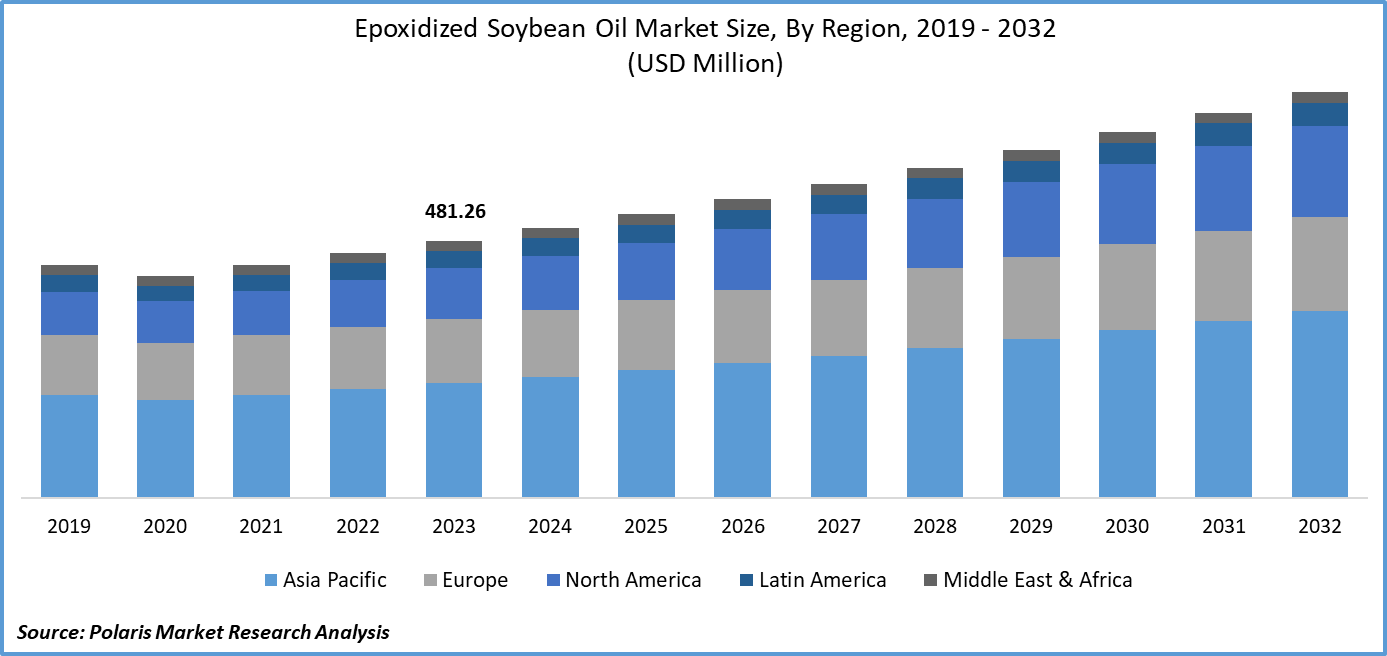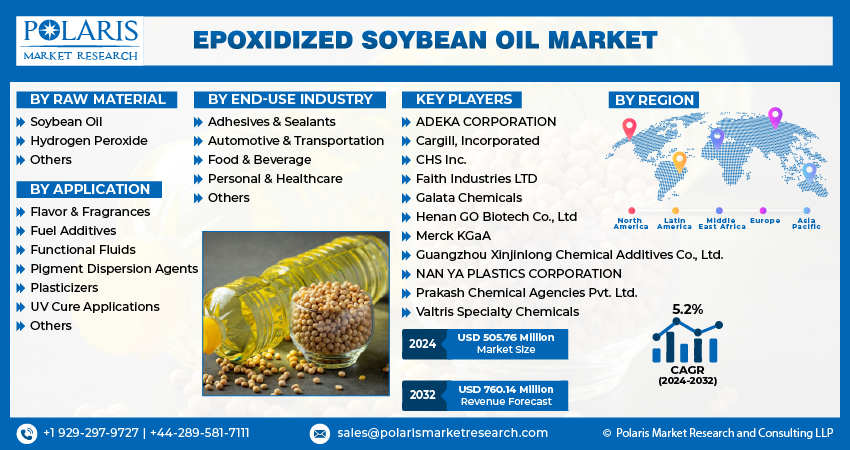
Epoxidized Soybean Oil Market Share, Size, Trends, Industry Analysis Report
By Raw Material (Soybean Oil, Hydrogen Peroxide, Others); By Application; By End-Use Industry; By Region; Segment Forecast, 2024 - 2032
- Published Date:Feb-2024
- Pages: 115
- Format: PDF
- Report ID: PM4596
- Base Year: 2023
- Historical Data: 2019 – 2022
Report Outlook
Epoxidized Soybean Oil Market size was valued at USD 481.26 million in 2023. The market is anticipated to grow from USD 505.76 million in 2024 to USD 760.14 million by 2032, exhibiting the CAGR of 5.2% during the forecast period
Industry Trends
Epoxidized soybean oil (ESO) is a vegetable oil derivative that has been epoxidized or reacted with an oxirane ring to create a stable, versatile, and non-toxic compound. It is made by reacting soybean oil with H2O2 (Hydrogen Peroxide) and an acid catalyst, resulting in a colorless, odorless, and viscous liquid.
The global market is anticipated to experience significant growth during the forecast period, driven by increasing demand from various end-use industries such as food and beverages, personal care, and healthcare. Epoxidized soybean oil is a versatile product that has gained popularity due to its excellent thermal stability, chemical resistance, and environmentally friendly nature. It is widely used as a substitute for traditional plasticizers in the production of flexible packaging materials, such as PVC, which has led to an increase in demand. In addition, the industry trends toward sustainable and eco-friendly products have further fueled the growth of the market.

To Understand More About this Research: Request a Free Sample Report
However, the major challenge faced by manufacturers is the high cost of production, which affects their profitability. Also, the availability of alternative products, such as bio-based plasticizers, poses a threat to the market's growth. Despite these challenges, the market outlook is expected to continue growing at an optimum pace. This growth is likely to be driven by increasing awareness about environmental concerns and the need for sustainable alternatives to traditional plasticizers.
Key Takeaways
- Asia Pacific dominated the market and contributed over 32% of epoxidized soybean oil market share in 2023
- By application category, the plasticizers segment dominated the global epoxidized soybean oil market size
- By end-use industry category, the food and beverage is projected to grow with a significant CAGR over the epoxidized soybean oil market forecast period

What are the market drivers driving the demand for the Epoxidized Soybean Oil market?
The growing demand for bio-based lubricants drives epoxidized soybean oil market growth.
The increasing demand for environment-friendly and sustainable products has led to significant growth in the market for bio-based lubricants, including epoxidized soybean oil (ESO). Consumers are seeking out alternatives to traditional synthetic lubricants that are derived from non-renewable sources and can have negative effects on the environment. Bio-based lubricants, such as ESO, offer an eco-friendly option that is made from renewable resources and biodegradable materials, reducing the carbon footprint and minimizing harmful emissions.
Also, ESO offers superior performance characteristics compared to regular mineral oil-based lubricants, such as improved thermal stability, better wear protection, and corrosion resistance, making it an attractive choice for various industrial applications. Along with this, governments' support through regulations and policies encouraging the use of bio-based products also drives the growth of the ESO market.
Which factor is restraining the demand for Epoxidized Soybean Oil?
The fluctuating raw material prices are hindering the epoxidized soybean oil market growth.
The market is facing challenges due to fluctuations in raw material prices. Soybeans, which are the primary input for producing epoxidized soybean oil, are subject to price volatility due to factors such as weather conditions, crop diseases, and shifts in global demand. When soybean prices increase, the cost of producing epoxidized soybean oil also rises, making it more expensive for manufacturers and consumers. Conversely, when soybean prices drop, producers may struggle to maintain profitability, leading to decreased production levels and reduced supply chain efficiency. These fluctuations can create uncertainty and instability in the market, making it difficult for stakeholders to predict future epoxidized soybean oil industry trends and invest in long-term growth strategies. As a result, the fluctuating raw material prices are hindering the growth of the market.
Report Segmentation
The market is primarily segmented based on raw material, application, end-use industry, and region.
|
By Raw Material |
By Application |
By End-Use Industry |
By Region |
|
|
|
|
To Understand the Scope of this Report: Speak to Analyst
Category Wise Insights
By Application Insights
Based on application analysis, the market has been segmented on the basis of flavor & fragrances, fuel additives, functional fluids, pigment dispersion agents, plasticizers, UV cure applications, and others. The plasticizers segment dominated the global market due to its versatile applications and growing demand from various end-use industries. Epoxidized soybean oil is commonly utilized as a plasticizer in the production of flexible polyvinyl chloride products like pipes, tubing, and vinyl flooring. It is also used in the production of other plastics, including polyethylene and polypropylene.
Epoxidized soybean oil is employed as a stabilizer and lubricant in the production of other materials, such as adhesives, coatings, and caulks. Its non-toxic and environment-friendly nature makes it an attractive alternative to synthetic plasticizers, driving up its demand in various industries. Thus, the increasing use of bio-based plasticizers, like epoxidized soybean oil, in place of phthalate-based plasticizers, which have raised health concerns, has contributed to the dominance of this segment.
By End-Use Industry Insights
Based on end-use industry category analysis, the market has been segmented on the basis of adhesives & sealants, automotive & transportation, food & beverage, personal & healthcare, and others. The food and beverage segment is expected to dominate the market during the forecast period due to its versatility and increasing demand for sustainable and healthier alternatives to traditional plasticizers. Epoxidized soybean oil, also known as ESBO, is a non-toxic, biodegradable, and renewable substance that can be utilized as a plasticizer in various applications, such as food packaging, bottles, and containers. It is an attractive alternative to phthalates, which have been linked to several health problems and are being phased out gradually. In addition, the use of ESBO in food packaging helps to reduce carbon footprints. It complies with regulations set by various governments and organizations, further boosting its adoption in this sector.

Regional Insights
Asia Pacific
The Asia Pacific region emerged as the dominant region in the global market in 2023 due to the increasing demand for bio-based lubricants and plasticizers in countries such as China, India, and Japan, which has driven the growth of the market in the region. Also, the presence of a large number of automotive and industrial manufacturers in the region who use epoxidized soybean oil as a raw material has contributed to its dominance. The availability of abundant soybean resources in countries like India, Indonesia, and Malaysia has made it easier for manufacturers in the region to access high-quality raw materials, thereby reducing production costs and increasing their competitiveness in the global market.
North America
The North American market for Epoxidized Soybean Oil is witnessing significant growth owing to the presence of major players in the region, such as CHS Inc., Cargill, and Valtris. The market is undergoing a dynamic transformation characterized by technological advancements and the rising need of non-phthalate plasticizers in the production of PVC compounds. In addition to this, the rising demand for biocompatible lubricants in the adhesive and sealant industry to comply with stringent regulations is also driving the growth of the market in the North American region.

Competitive Landscape
The global market is highly competitive, with market key companies vying for epoxidized soybean oil market share. The major players in the market include companies such as Cargill, CHS Inc., and Faith Industries Ltd, which have a strong presence in the food packaging industries. These companies have diverse product portfolios and strong distribution networks, which enables them to cater to various end-use industries. Also, several small-scale companies operate in regional markets, providing stiff competition to the larger players.
Some of the major players operating in the global market include:
- ADEKA CORPORATION
- Cargill, Incorporated
- CHS Inc.
- Faith Industries LTD
- Galata Chemicals
- Guangzhou Xinjinlong Chemical Additives Co., Ltd.
- Henan GO Biotech Co., Ltd
- Merck KGaA
- NAN YA PLASTICS CORPORATION
- Prakash Chemical Agencies Pvt. Ltd.
- Valtris Specialty Chemicals
Recent Developments
- In September 2021, Cargill agreed to acquire Arkema's epoxides business, which will include a manufacturing facility situated in Blooming Prairie, Minnesota. Through this acquisition, Cargill is expected to enhance its production capacity in bio-based plasticizers and polyols, thereby enabling the company to better cater to its industrial clientele.
Report Coverage
The Epoxidized Soybean Oil market report emphasizes key regions across the globe to provide a better understanding of the product to the users. Also, the report provides market insights into recent developments and trends and analyzes the technologies that are gaining traction around the globe. Furthermore, the report covers an in-depth qualitative analysis pertaining to various paradigm shifts associated with the transformation of these solutions.
The report provides a detailed analysis of the market while focusing on various key aspects such as competitive analysis, raw material, application, end-use industry, and their futuristic growth opportunities.
Epoxidized Soybean Oil Market Report Scope
|
Report Attributes |
Details |
|
Market size value in 2024 |
USD 505.76 million |
|
Revenue Forecast in 2032 |
USD 760.14 million |
|
CAGR |
5.2% from 2024 – 2032 |
|
Base year |
2023 |
|
Historical data |
2019 – 2022 |
|
Forecast period |
2024 – 2032 |
|
Quantitative units |
Revenue in USD million and CAGR from 2024 to 2032 |
|
Segments Covered |
By Raw Material, By Application, By End-Use Industry, By Region |
|
Regional scope |
North America, Europe, Asia Pacific, Latin America, Middle East & Africa |
|
Customization |
Report customization as per your requirements with respect to countries, regions, and segmentation. |
FAQ's
key companies in Epoxidized Soybean Oil Market are ADEKA CORPORATION, Cargill, Incorporated, CHS Inc., Faith Industries LTD, Galata Chemicals, Guangzhou Xinjinlong Chemical Additives Co., Ltd
Epoxidized Soybean Oil Market exhibiting the CAGR of 5.2% during the forecast period
The Epoxidized Soybean Oil Market report covering key segments are raw material, application, end-use industry, and region.
key driving factors in Epoxidized Soybean Oil Market are the growing demand for bio-based lubricants drives market growth
The global Epoxidized Soybean Oil market size is expected to reach USD 760.14 Million by 2032
